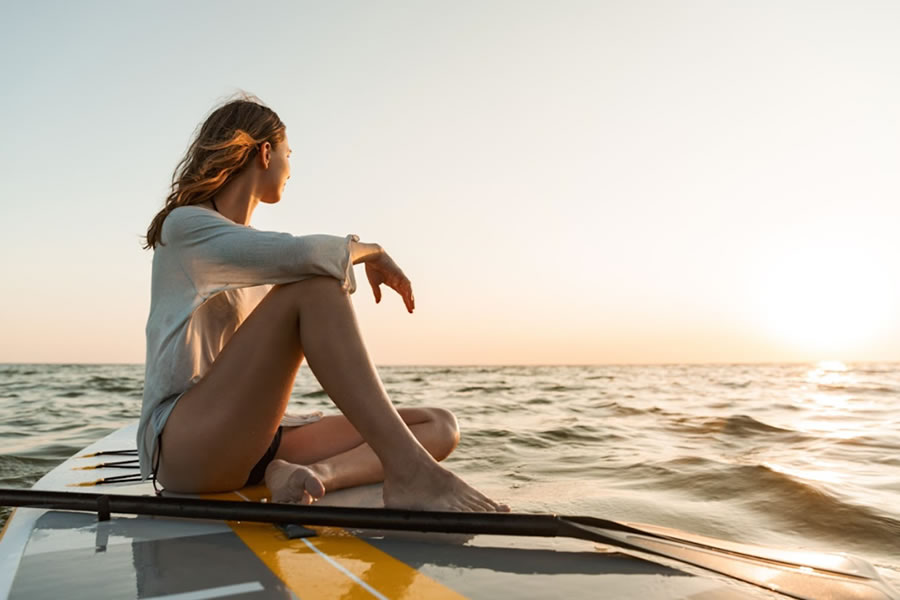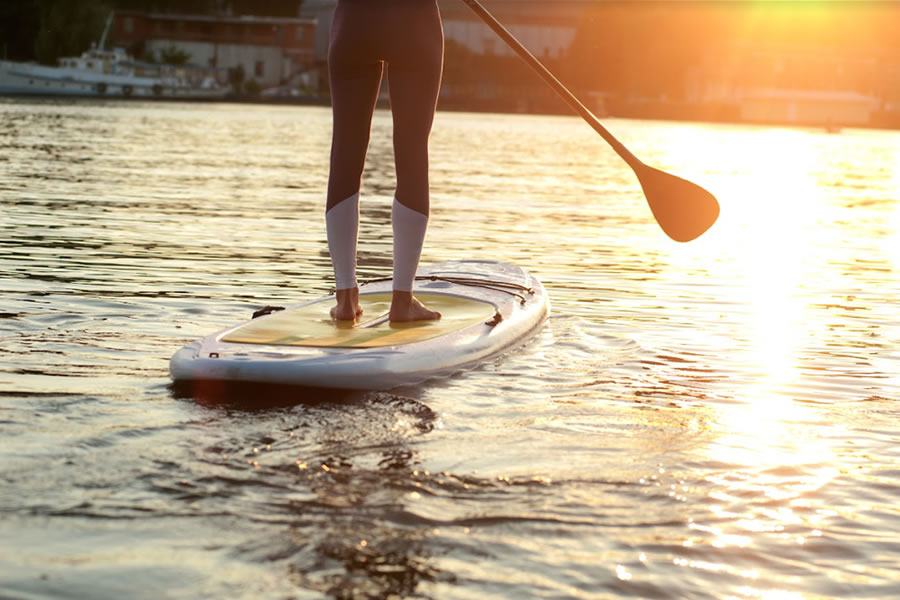🌎 Stand Up Paddle Boarding: 12 Tips For Beginners

(Sportalsub.net)
If you think of an activity that can be done in oceans, lakes, bays, or even rivers, stand up paddle boarding must first come into your mind. It’s a great full-body core workout and a fantastic way to enjoy the beautiful waters that surround the planet. The best part is that it can be done by people of all ages, skill levels, and body types.
Before you embark on your first paddle board adventure, there are a few essential tips and techniques to master. With that said, keep reading to learn everything from selecting the best paddle board to employing a few paddling techniques and tips.
Choose Custom Watersports Lanyard-id-holder
ID or important small items such as keys are a very important thing when playing water sports because they are very easy to lose, but they must be carried. Many Standup paddle board clubs are made for their members with custom lanyards of ID holders with their own logos or names. In addition to saving important items, they are also very fashionable. The most important thing is that they can quickly confirm their identity and promote their club through specific colors and logos.
Choosing The Ideal Paddle Board
Stand up paddle boards come in a variety of shapes and sizes; you can learn more about them by visiting https://onyxmotion.com or other paddle-board-related websites. Paddle-boards can also be customized by attaching custom pvc patches to the paddle-boards, this way you can get a unique personal touch on your paddle-boards. Make sure you are using PVC or rubber patches as these patches are waterproof and durable for water related activities. You can get creative and customize these pvc patches with your club and team logos. However, the most common types of paddle boards are the traditional epoxy paddle board, also known as a hard paddle board, and the inflatable paddle board. Both are excellent choices, depending on your lifestyle and requirements.
A stand-up paddle board is significantly thicker than a typical surfboard. It typically measures eight to 12 feet long, 28 to 32 inches in width, and four to five inches thick. As a beginner, it’s best to go with a wider, thicker, and longer board. This will provide you with the most stability as you learn to paddle board. After you’ve gotten the hang of it, you may then progress to a smaller paddle board.
Preparing The Necessary Paddle Boarding Equipment
Once you’ve chosen your ideal paddle board, you’ll also need a few pieces of equipment to support you throughout your paddle boarding experience. Here are as follows:
- Stand Up Paddles
Paddles that are intended for stand up paddle boarding come in a variety of constructions, such as aluminum, plastic, carbon fiber, and wood. Such constructions have varying blades, handles, and shaft shapes. Regardless, the best paddle should always be six to ten inches higher than your height.
- Leash
A leash for stand up paddle boarding keeps your paddle board attached to you. It’s usually a Velcro strap that’s wrapped around your ankle or calf. Although leashes are available in a range of sizes, your leash should be the same size as or slightly smaller than the size of your board.
- Board Bags
If you want to extend the life of your board, you might consider getting a board bag. The good news is that most inflatable paddle boards come with their own board bags.
- Personal Flotation Device (PFD)
When you’re paddle boarding, surfing, or engaging in any recreational activity in the water, it’s crucial that you’re prepared for anything. As such, ensure that you have a paddle board life vest to keep you afloat in the event of a fall.

Beginner Tips For Stand Up Paddle Boarding
Now that you’ve acquired a paddle board and are aware of the necessary equipment to bring, you’re ready to go! However, there are a few things you should keep in mind to prevent the most typical beginner paddle boarder mistakes. In the long run, what you learn will benefit your first paddle boarding experience.
1. Practice On Dry Land Before Going In The Water.
The simplest approach to learning and practicing standing up on a paddle board is by practicing on firm ground. In this manner, you’ll become accustomed to the idea of standing on your board. When the time comes for you to hit the water, balancing on an uneven surface will be more bearable.
2. Find The Perfect Spot To Launch
As a beginner, make it easier for yourself by launching from a sandy, deep beach on a peaceful day! You must provide yourself with as many advantages as possible.
3. Never Forget To Use The Leash
The earlier you keep this tip in mind, the safer you and everyone else will be. The leash is essential in any boarding activity. In the case of a fall, currents and winds can quickly whisk your paddle board away from you—and into the ocean. Once your board gets carried by the force of an ocean wave, it might be dangerous as it may hit you or other nearby elements. As a result, remember to always use your leash!
4. Always Face The Right Direction
Most beginners find it difficult to determine which of the board’s ends is the front and which is the nose. Hence, before you climb on the board, check where the board’s fins are; they should be at the back when you paddle. Their function is to keep your board straight when paddling. However, if you ride with the fins forward, your board will most likely be unstable and not go straight despite your efforts.
5. Strengthen Your Core To Paddle
While paddle boarding, don’t use your arms—paddling is best done by your core. Paddling with your arms would be exhausting, and you wouldn’t get much power out of it. However, if you paddle with your core, you’ll obtain the most effective power for your paddle strokes because it’s where your body’s strongest muscles are located.
6. Look Ahead
When you first start standing up paddle boarding, it’s tempting to gaze down at your board, watch the water reach your feet, and hope you don’t fall in—avoid all these. Instead, keep your head up high. When floating in the water, keep your back straight, your body weight over your toes, and your gaze fixed on the horizon. If you keep your head down, watching your toes, you’re more likely to bounce back on your heels or, worse, fall in the water!
7. Maintain A Safe Distance From Other Elements
The oceans are vast, rivers are long, and lakes are enormous. Therefore, there should be no justification for not staying out of the way.
Beginners tend to paddle board in the same square inch of water. However, since paddle boards are large and might cause injury to other paddle boarders, it’s advisable to keep your distance from people or other elements. Make sure you have enough space to practice standing, paddling, and even falling.
8. Fall Off Your Board The Proper Way
While you’re practicing your paddle boarding strokes, you should also think about how you fall. Falling is normal; even professional paddle boarders fall, too. Hence, learn how to fall off the right way. You’ll eventually understand that practicing falls or, at the very least, knowing how to fall properly, can help ensure that an injury doesn’t hamper your paddle boarding experience.
To begin, paddle boards are large and can cause injury if they crash with you. To avoid striking yourself on it, fall away from it; don’t trip over the board or the fins. You also don’t have to worry about losing your board because you’re already using a leash.
9. Practice Climbing Back On Your Board
Climb back on your board repeatedly until it becomes simple to you. Besides that, doing so gives you a reason not to panic, too.
To begin, move to the center of the board and grab the handle with one hand, while holding the far edge with the other. Then, instead of kicking your feet out in front of you, kick them out behind you. Following that, give yourself a mighty push and pull to raise your chest up on the board with your arms. Finally, turn around on your knees and face the front.
10. Ride Only The Waves That You’re Capable Of Handling
When you’re standing up paddle boarding in the ocean, seeing a wave might tempt you to ride it. However, as a beginner, you must be cautious and only ride waves suitable for your abilities. Even if you feel challenged by an oncoming large wave, it’s critical that you remain aware of your own skills. You must remember that nature is powerful, and you must treat it with respect. Therefore, before riding an ocean wave or flow of a river, assess the power of the water first.
11. Keep An Eye Out For The Winds
In addition to the preceding number, it’s critical to be aware of the weather conditions before engaging in a stand up paddle boarding activity. Being on a paddle board is similar to being a sail in the wind, where you either control your board or the wind controls you.
With that in mind, make sure you’re aware of the forecast so you can plan accordingly. However, if you find yourself caught in a rapid wind change, lay down with your paddle tucked beneath you and paddle the board, similar to how one would lie on a standard surfboard. This is referred to as paddling prone.
12. Relax!
At the end of the day, the most important thing you have to do is relax. Lessen your worries, and just keep your legs and knees flexible enough to ride the water’s movement. After all, stand up paddle boarding is a fun and relaxing sport!
Final Word
Paddling activities like stand up paddle boarding don’t have to be complicated. By following the essential tips listed above, it may be much easier for you to get started and have fun. Just don’t give up right away and keep practicing. In the long term, stand up paddle boarding may not feel like a difficult challenge anymore!
Last Updated on March 3, 2023


